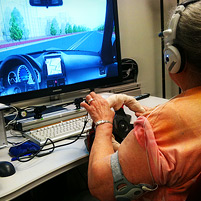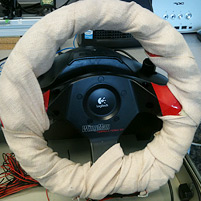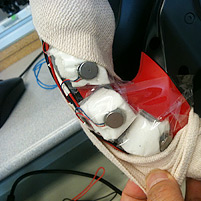Driver Safety

Haptic simulator


Haptic steering wheel actuators
A vibrating steering wheel is an effective way to keep a driver's eyes safely on the road.
Researchers at Carnegie Mellon University and AT&T Labs have shown that it provides an additional means to convey directions from a car's navigation system.
The study is one of the first to evaluate combinations of audio, visual and haptic feedback for route guidance.
It found that younger drivers in particular were less distracted by a navigation system's display screen when they received haptic feedback from the vibrating steering wheel.
For elder drivers, the haptic feedback reinforced the auditory cues they normally prefer.
Though the haptic steering wheel generally improved driver performance and safety, the study findings suggest that simply giving the driver additional sensory inputs isn't always optimal.
That's particularly the case for older drivers because the additional sensory feedback can strain the brain's capacity to process it.
"Our findings suggest that, as navigation systems become more elaborate, it would be best to personalize the sensory feedback system based, at least in part, on the driver's age," said SeungJun Kim, systems scientist in Carnegie Mellon's Human-Computer Interaction Institute (HCII).
The findings will be presented June 21 at the International Conference on Pervasive Computing in Newcastle, England.
Vibrating steering wheels already are used by some car makers to alert drivers to such things as road hazards.
But the haptic steering wheel under development by AT&T is capable of unusually nuanced pulsations and thus can convey more information.
Twenty actuators on the rim of the AT&T wheel can be fired in any order. In this study, firing them in a clockwise sequence told a driver to turn right, while a counterclockwise sequence signaled a left turn.
"By using these types of vibration cues, we are taking advantage of what people are already familiar with, making them easier to learn," explained Kevin A. Li, a researcher with AT&T's user interface group.
Kim and fellow HCII scientists have developed methods for measuring the performance, attentiveness and cognitive load of drivers that involve a suite of sensors. For this study, they added the experimental AT&T steering wheel to their driving simulator.
Part of a research thrust of the National Science Foundation-sponsored Quality of Life Technology Center, the researchers were particularly interested in learning whether multi-modal feedback would improve the driving performance of elderly drivers in order to help them maintain mobility and independence.
They found that the time that a driver's eyes were off of the road was significantly less with the combination of auditory and haptic feedback than with the audio and visual feedback typical of most conventional GPS systems — four percent less for elder drivers and nine percent less for younger drivers.
Related Links: Read the Press Release | Human Computer Interaction Institute | Quality of Life Technology Center | School of Computer Science
